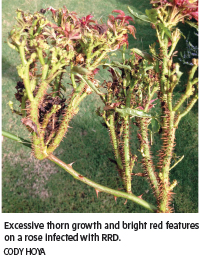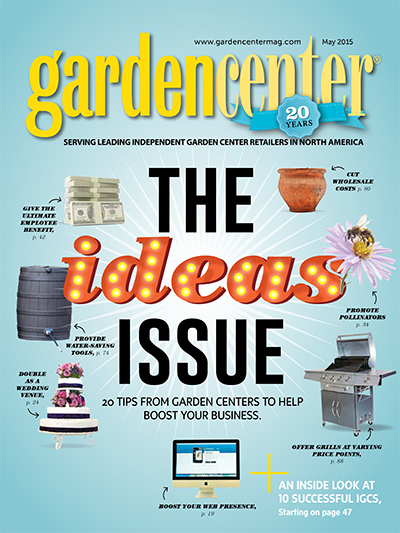
 Every once and a while, a plant disease comes along that impacts the entire industry in a big way. Rose rosette is one of those diseases, and there’s no hiding from it. It’s time for garden centers and nurseries to make sure staff is fully informed about the virus, have plans for managing the disease in-house and commit to accurate consumer education.
Every once and a while, a plant disease comes along that impacts the entire industry in a big way. Rose rosette is one of those diseases, and there’s no hiding from it. It’s time for garden centers and nurseries to make sure staff is fully informed about the virus, have plans for managing the disease in-house and commit to accurate consumer education.
RRD on the move
Rose rosette disease (RRD) has already spread through the north-central, south-central and southeast U.S. and now threatens western states. If you live in a mid-southern state, you may have seen an explosion of the virus over the past couple of years, most likely due to the high concentrations of mass plantings of shrub roses. Knock Out and Drift roses have been hit hard due to their popularity and mass plantings, but they are no more susceptible to RRD than any other rose variety. All are targets for the disease, and here in Texas, heavily planted roses are being removed in bulk to combat the virus.
“Rose rosette disease joins the rogue’s gallery of recent ornamental plant afflictions, boxwood blight and impatiens downy mildew,” Steve Hutton, CEO and president of Star Roses & Plants/Conard-Pyle, wrote to Garden Center magazine in an email. “As with these diseases, the battle against RRD will be won with academic research, innovative plant breeding and good horticultural practice.”
Rose rosette, also called “witches broom,” is a virus transmitted by a tiny eriophyid mite, Phyllocoptes fructiphilus.  The disease infects only plants within the genus Rosa, which includes all roses. Multiflora rose (Rosa multiflora) is highly susceptible to the virus. Areas with native populations of multiflora rose are at higher risk for landscape rose infection. The disease can spread quickly as the mites move from plant to plant. The virus is also transmitted by pruning and grafting to infected rootstock.
The disease infects only plants within the genus Rosa, which includes all roses. Multiflora rose (Rosa multiflora) is highly susceptible to the virus. Areas with native populations of multiflora rose are at higher risk for landscape rose infection. The disease can spread quickly as the mites move from plant to plant. The virus is also transmitted by pruning and grafting to infected rootstock.
RRD symptoms include:
- Bright red leaves and branches emerge
- Distorted, twisted leaves and branches
- Overabundance of foliage and buds
- Excessive thorns so dense that you may not see the branches themselves
- Bright red thorns.
Because many roses naturally present red foliage color on new growth, discoloration isn’t always a reliable symptom for home gardeners. The symptom most people notice first is the “witches broom” effect. This is when a multitude of stems and leaves grow en masse with dense clusters of thorns. Unfortunately, this symptom is often confused with drift from broadleaf weed killer. However, herbicide damage doesn’t result in an overgrowth of excess foliage or flower buds. Customers should look for a combination of the symptoms listed.
In the garden center
I spoke with Cody Hoya, general manager for North Haven Gardens (NHG) in Dallas, to see how he was handling RRD. Because the disease has had a big impact on the Dallas/Fort Worth area, I was curious if they’d seen it in their nursery stock and what customers are saying.
“The rate of customer inquiry has peaked sharply as public awareness increases,” Hoya says. “We initially communicated with state and local rosarians to determine our ‘common voice’ and ensure that we as a staff presented a unified front on the issue.”
 When it comes to diagnosing RRD for customers, NHG has taken a smart approach. They ask customers not to bring in live samples of plants if they think RRD is present, but instead bring photos to the store or email them.
When it comes to diagnosing RRD for customers, NHG has taken a smart approach. They ask customers not to bring in live samples of plants if they think RRD is present, but instead bring photos to the store or email them.
“We want to be cautious about potential spread through sample branches or whole shrubs being brought into the nursery,” Hoya says. “Customers can also schedule an at-home appointment with our garden coach, who can assist in confirming rose rosette on-site.” Keeping the infected plants off-property is a must when it comes to preventing the spread of the mites and virus. NHG has spotted one infected rose in their on-site plantings, which they removed immediately.
True or false
Not everyone in the gardening community is up to date on current research or on the proper way to handle the disease. Misinformation amongst customers still plagues local garden centers like NHG.
“There are members of the local gardening community who continue to spread public information on RRD that is considered false and misleading by most professionals,” Hoya says. “So it requires us in the industry to be consistent when fielding the resulting public confusion. Further, we have created new informational handouts (nhg.com/PDF/RoseRosetteHandout.pdf), included RRD in our blog content, and stepped up training efforts to promote good stewardship of existing roses as well as the best alternatives for those customers wishing to avoid replanting them.”
The reality is that there is currently no successful treatment or cure for rose rosette. Once infected, plants have an average lifespan of about 22 months. It’s this slow death that gives many gardeners false hope that their sprays or pruning may have “saved” their plants.
|
Save the roses With the help of a $4.6 million award from the USDA this past fall, researchers have set in motion a number of efforts to thwart the deadly and costly rose rosette disease (RRD). The funds were matched by $4.6 million of in-kind and cash contributions from growers and breeders both big and small, as well as some major landscape companies, says Mike Dobres, managing director of NovaFlora LLC, the research and breeding division of Star Roses and Plants/Conard-Pyle. The funds will be used to develop best management practices, expand outreach and education efforts, and to map genes for RRD resistance in roses. The disappearance of this genus in the nursery industry would remove some $400 million in domestically grown plant sales, according to Star Roses and Plants/Conard-Pyle. The research funding represents the culmination of a two-year initiative originally conceived and funded by Star Roses and Plants/Conard-Pyle to reach out to key university researchers and industry leaders to respond to the serious threat that RRD represents. Dobres has led the charge in many of the initiatives of the past few years regarding RRD. The grant enables the next wave of RRD research to have three main objectives. “One, we’ll further develop diagnostic tools. Second, we’ll learn more about how the disease spreads and develop cultural recommendations, and third, we’ll map the rose genes for disease resistance,” he says. —Kelli Rodda, editor, Nursery Management. For the full article from the May issue, visit nurserymag.com/nm0415-fight-rose-rosette-disease.aspx |
Industry growers have access to several miticides (Avid, Akari, Judo), which when used in rotation have been shown to reduce RRD infection rates. However, spraying pesticides in the landscape isn’t yet considered a reliable control approach. Systemic mite treatments available to homeowners, such as imidacloprid products, are ineffective against the mites. Miticides registered for spider mites are also ineffective.
While pesticides such as bifenthrin, carbaryl, horticultural oils and insecticidal soap might provide some protection from mites if applied when they are active, they’re no guarantee against disease transmission. Spraying in the landscape is not recommended as a stand-alone option; but it can serve as a preventive on uninfected plants in conjunction with removal of infected plants.
There have been some attempts to control the disease using strategic pruning, but that hasn’t yet been proven effective. Often, even if a symptomatic cane is removed, the mites still remain on the plant to spread RRD to new canes. Also, it can take many months before newly infected canes show any symptoms and can be identified.
Removal is responsible
Until more is known, the safest recommendation is to immediately remove infected plants and destroy them. All leaf litter should also be manually removed (not by leaf blower), as that is where mites can remain behind. The entirety of the root system must also be completely removed from the soil, as infected shoots can re-emerge from root remnants. Remind your customers that by leaving infected plants in the ground, they’ll not only eventually lose the plant, but also potentially spread the disease to their other roses or their neighbor’s plants.
Go local
When you’re developing your “voice” and educational platform about RRD, be sure to reach out to your local extension research center and local botanical gardens and arboretum; it’s best to make sure you’re all on the same page. Extension labs can test for the disease. Many of your customers will either see the disease or get recommendations from public gardens.
Julie Hollingsworth Hogg, horticulturist at the Atlanta Botanical Garden, says they’ve had to be diligent in managing their display plantings of roses. They’ve already removed 14 infected rose plants from display and proactively removed Knock Out roses that were planted en masse in an effort to slow the spread of RRD. Hogg says they encourage visitors to use their local resources for help. “We are always willing to tell visitors what we have tried, but we also believe that homeowners in the United States should take advantage of the extension service in their home state,” she says. “This is where they will find the latest research and recommendations for dealing with this troubling virus.”
Stay current
Be sure to keep an eye on new research. In 2014, The USDA National Institute of Food and Agriculture awarded Texas A&M AgriLife Research an almost $4.6 million Specialty Crop Research Initiative grant to help find a solution to RRD. For more on research, see the sidebar on page 32. Updates are posted on the AmericanHort Rose Rosette information site at roserosettedisease.com.
Hoya says that’s exactly what they’ve done at NHG. “In January of this year, three of our managerial staff and two of our sales people attended a day-long conference on RRD with local extension agents, horticulturists, rosarians and landscape professionals,” Hoya says. When it comes to educating their customers, they’ve also been proactive about publishing information on RRD. “Our first public handout was produced in late 2013 with an illustrative photo and recommended steps for stopping the spread of the disease. It was part of an all-staff training meeting, and we rehearsed responses to various inquiries and differing opinions.” NHG has since updated its customer handout, which can be found on their website, with the latest research information.
Leslie (CPH) owns Halleck Horticultural, LLC, through which she provides horticultural consulting, digital content marketing, branding design, advertising and social media support for green industry companies. www.lesliehalleck.com

Explore the May 2015 Issue
Check out more from this issue and find your next story to read.
Latest from Garden Center
- GS1 US Celebrates 50-Year Barcode 'Scanniversary' and Heralds Next-Generation Barcode to Support Modern Commerce
- Weekend Reading 7/26/24
- Retail Revival: Making gardening contagious
- ‘Part of our story’
- Registration now open for Garden Center Fertile Ground Webinar Series
- Dramm introduces new hose, sprinkler attachments for home gardeners, nurseries
- Meet the 15 Retailers' Choice Awards winners from Cultivate'24
- 2024 Top 100 Independent Garden Centers List





